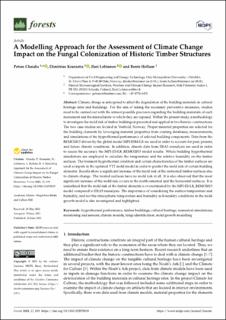| dc.contributor.author | Choidis, Petros | |
| dc.contributor.author | Kraniotis, Dimitrios | |
| dc.contributor.author | Lehtonen, Ilari | |
| dc.contributor.author | Hellum, Bente | |
| dc.date.accessioned | 2021-06-28T13:51:41Z | |
| dc.date.available | 2021-06-28T13:51:41Z | |
| dc.date.created | 2021-06-22T21:55:08Z | |
| dc.date.issued | 2021-06-22 | |
| dc.identifier.citation | Forests. 2021, 12 (7), (1-28). | en_US |
| dc.identifier.issn | 1999-4907 | |
| dc.identifier.uri | https://hdl.handle.net/11250/2761721 | |
| dc.description.abstract | Climate change is anticipated to affect the degradation of the building materials in cultural heritage sites and buildings. For the aim of taking the necessary preventive measures, studies need to be carried out with the utmost possible precision regarding the building materials of each monument and the microclimate to which they are exposed. Within the present study, a methodology to investigate the mold risk of timber buildings is presented and applied in two historic constructions. The two case studies are located in Vestfold, Norway. Proper material properties are selected for the building elements by leveraging material properties from existing databases, measurements, and simulations of the hygrothermal performance of selected building components. Data from the REMO2015 driven by the global model MPI-ESM-LR are used in order to account for past, present, and future climate conditions. In addition, climate data from ERA5 reanalysis are used in order to assess the accuracy the MPI-ES-LR_REMO2015 model results. Whole building hygrothermal simulations are employed to calculate the temperature and the relative humidity on the timber surfaces. The transient hygrothermal condition and certain characteristics of the timber surfaces are used as inputs in the updated VTT mold model in order to predict the mold risk of certain building elements. Results show a significant increase of the mold risk of the untreated timber surfaces due to climate change. The treated surfaces have no mold risk at all. It is also observed that the most significant increase of the mold risk occurs in the north-oriented and the horizontal surfaces. It is underlined that the mold risk of the timber elements is overestimated by the MPI-ES-LR_REMO2015 model compared to ERA5 reanalysis. The importance of considering the surface temperature and humidity, and not the atmospheric temperature and humidity as boundary conditions in the mold growth model is also investigated and highlighted. | en_US |
| dc.language.iso | eng | en_US |
| dc.publisher | MDPI | en_US |
| dc.relation.ispartofseries | Forests;volume 12, issue 7 | |
| dc.relation.uri | https://www.mdpi.com/1999-4907/12/7/819 | |
| dc.rights | Navngivelse 4.0 Internasjonal | * |
| dc.rights.uri | http://creativecommons.org/licenses/by/4.0/deed.no | * |
| dc.subject | Hygrothermal performances | en_US |
| dc.subject | Timber buildings | en_US |
| dc.subject | Cultural heritages | en_US |
| dc.subject | Numerical simulations | en_US |
| dc.subject | Monitoring | en_US |
| dc.subject | Sensors | en_US |
| dc.subject | Climate models | en_US |
| dc.title | A Modelling Approach for the Assessment of Climate Change Impact on the Fungal Colonization of Historic Timber Structures | en_US |
| dc.type | Peer reviewed | en_US |
| dc.type | Journal article | en_US |
| dc.description.version | publishedVersion | en_US |
| dc.rights.holder | © 2021 by the authors. | en_US |
| dc.source.articlenumber | 819 | en_US |
| cristin.ispublished | true | |
| cristin.fulltext | original | |
| cristin.qualitycode | 1 | |
| dc.identifier.doi | https://doi.org/10.3390/f12070819 | |
| dc.identifier.cristin | 1917830 | |
| dc.source.journal | Forests | en_US |
| dc.source.volume | 12 | en_US |
| dc.source.issue | 7 | en_US |
| dc.source.pagenumber | 28 | en_US |
| dc.relation.project | EC/H2020/821054 | en_US |

